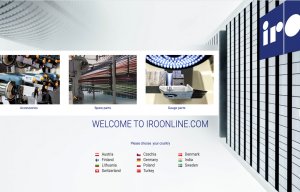
Vandewiele Sweden pioneers new e-commerce platform
Development overcomes limitations in stretchable electronics manufacturing.

26th March 2021
Innovation in Textiles
|
Hong Kong
The Hong Kong Polytechnic University (PolyU) has developed a highly permeable and superelastic conductor which can be used for wearable electronic devices that can withstand long-time wearing.
The novel conductor is fabricated by coating or printing liquid-metal onto an electrospun elastomeric fibre mat, which offers high permeability, stretchability, conductivity and electrical stability allowing it to be employed in various applications including health monitoring devices, soft robotics and on-skin electronics.
Electronic devices and systems with high stretchability are essential in the fields of wearable electronics, on-skin electronics, soft robotics and bioelectronics. However, many stretchable electronics are fabricated with impermeable elastic thick films and wearing them for long periods can cause health concerns including skin irritation and inflammation. In addition, low permeability will limit the use of multi-layered devices and hinder the development of advanced functionality of stretchable electronics.
To overcome these limitations, the research team led by Professor Zijian Zheng, of PolyU’s Institute of Textiles and Clothing (ITC), have developed a new type of highly permeable superelastic conductor. The conductor enables the fabrication of biocompatible and multifunctional monolithic stretchable electronics.
LMFM
The new liquid-metal fibre mat (LMFM) and is fabricated by coating or printing liquid metal onto an electrospun elastomeric fibre mat followed by a mechanical activation process in which the liquid metal self-organises into a laterally porous and vertically buckled film hanging among the fibres.
The LMFM possesses excellent permeability, retains super elasticity and ultrahigh conductivity in tensile testing. In addition, it shows excellent biocompatibility when directly applied to the human skin.
“We selected eutectic gallium-indium alloy (EGaIn), a type of liquid metal commonly used in soft electronics such as flexible printed circuit boards, as the conductive component for printing on the stretchable poly(styrene-block-butadiene-block-styrene) (SBS) mat, a material that is usually used for rubber products like gloves or balloons as an elastomer, to fabricate the LMFM,” Professor Zheng explained.

EGaIn is a metal that can be maintained in a liquid state under room temperature. It has low viscosity, high conductivity and low toxicity, and is also capable of forming a thin solid layer of oxide (Ga2O3) rapidly on the surface of EGaIn upon exposure to air, offering soft and stretchable features. After stretching, the oxide formed on the surface of EGaIn buckles breaks up into holes providing an accordion-like structure for high stretchability and conductivity through the wrinkles.
Stacking
Furthermore, the LMFM can be fabricated vertically and stacked in three layers of printed EGaIn electrical circuits on monolithic elastic mats – with one layer acting as an electrocardiography (ECG) sensor, another as a sweater sensor, and the final layer as an electrothermal heater. The fabricated three-layer sample, with a total thickness of 1mm, performs well while maintaining high permeability. It implies that the stacked architecture of the LMFM can provide excellent wearing comfort and multifunctionality.
In summary, LMFM is a new type of stretchable conductor that is easily made by coating or printing liquid metal onto an elastic electrospun fibre mat. With a simple pre-stretch process, it can offer high permeability as well as conductivity. LMFM is also able to be stacked in multiple layers while maintaining high permeability. This permeable and stretchable conductor can be adopted as a user-friendly platform needed to fabricate monolithic stretchable electronics that provide high integration density, multifunctionality and long-time wearability.
The research team announced their work in Nature Materials.

Business intelligence for the fibre, textiles and apparel industries: technologies, innovations, markets, investments, trade policy, sourcing, strategy...
Find out more